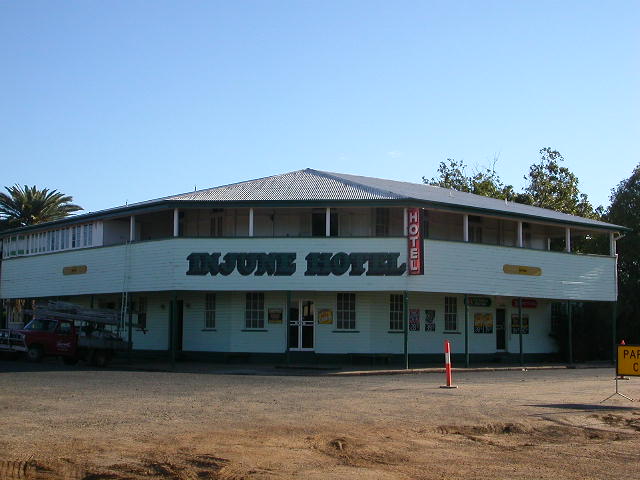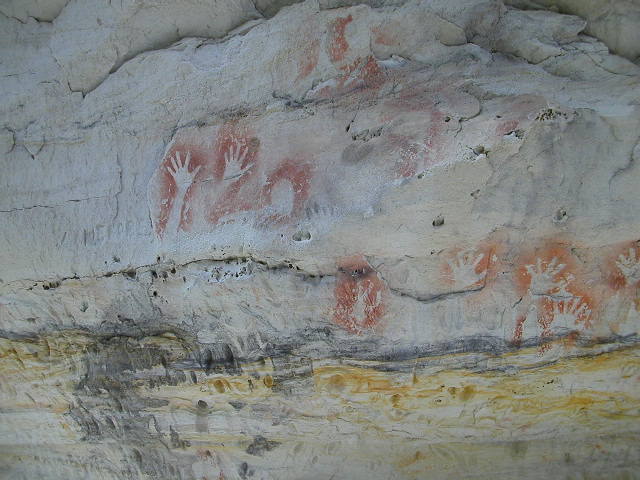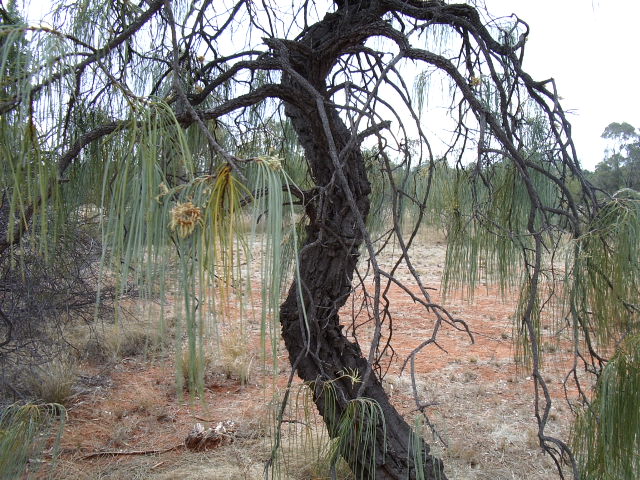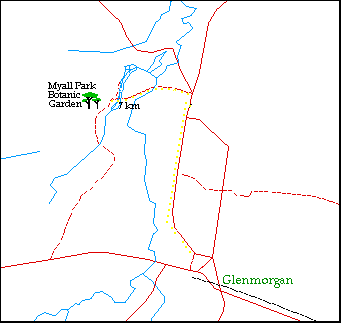
 |
| CARNARVON GORGE :: QUEENSLAND :: 29.4 S 149.8 E   CARNARVON Gorge is one of Australia's best kept secrets, a spectacular oasis of strange plants and even stranger animals located in the heart of Queensland's cattle country. While the Australian continent as a whole can be considered a repository of prehistoric wildlife now extinct in the rest of the world, Carnarvon Gorge goes one step further. Between the towering sandstone cliffs of the Gorge survive plants and animals which long ago disappeared from the rest of the continent, and are unusual even by Australian standards. Many of these specimens are relics from a time, millions of years ago, when Australia was a cooler, wetter place. They combine to give the Gorge a tropical, somewhat Asian appearance, in lush contrast to the surrounding arid plains. As well as miles upon miles of excellent trekking paths, moist valleys and rugged ranges, all contained within a 280,000 hectare national park, Carnarvon Gorge also features two ancient Aboriginal art galleries. If the many delights of the Gorge are not enough to satisfy you, the surrounding plains are studded with interesting attractions including a native botannical garden at Myall Park, a few hours drive to the south. THE RISE OF THE GREY NOMADS  IN recent years in Australia there has been an explosion of travel to areas previously off the "tourist route", notably the vast rural Outback. At the same time, a new breed of Australian traveller has emerged: Grey Nomads, retired couples who cash in their life savings to spend months at a time on the road, living in caravans and visiting the most unlikely places. Carnarvon Gorge, previously unknown to many Australians, has become one of the Grey Nomads' favourite destinations. However, you don't have to to grey or nomadic to appreciate Carnarvon Gorge, the only prerequisite is that you enjoy nature. There are two main accomodation sites -- Carnarvon Gorge Wilderness Lodge (www.carnarvon-gorge.com) and the Takarakka Bush Resort (www.takarakka.com.au/). The Wilderness Lodge is the more upmarket of the two, with "unique timber and canvas safari cabins" starting at $AUD70 per person per night. Takarakka Bush Resort has a mix of bush cabins, caravan and camping sites, with prices ranging from $AUD9 per person per night for the camp sites to $AUD70 per night for two adults in the canvas cabins. You have to take your own sleeping ware and cooking equipment. When I visited Takarakka Bush Resort recently I found it overrun with Grey Nomads cooking sausages in the communal open-air barbeque kitchen or drinking wine around the fire, and during my three-day stay I only encountered two foreign tourists in the entire national park -- a couple of German backpackers. Perhaps in time Carnarvon Gorge will become more popular with foreign tourists, but for now it seems to be a Grey Nomad secret. NATURAL DELIGHTS  THE thing to do at Carnarvon Gorge is to go on one of the several guided walking tours, including a night spotlighting tour, or to go it alone and trek by yourself. Perhaps a mix of the two is the best approach. There are over 20 km of walking tracks leading to beautiful side gorges and waterfalls, high lookouts and Aboriginal art galleries. One of the most popular attractions is the Moss Garden, a place of lush, primordial beauty soaked by spring water from the highly absorbant sandstone cliffs. Another popular site is the Amphitheatre: a large chasm carved out by millions of years of erosion. The Art Gallery, a 5.4km walk from the visitors area, includes more than 2000 Aboriginal engravings, ochre stencils and freehand paintings on a 62-metre stretch of sandstone wall. The art is thousands of years old and considered some of the finest in Aboriginal Australia. Gazing at the art, you might imagine back to a time when Aborigines lived in the gorge, living off a diet of roots, seeds, fruits, wallabies (small kangaroos) and bandicoots. As stated before, Carnarvon Gorge is packed with wildlife, some of it quite rare. Several different species of kangaroo can be regularly seen in the national park. Two of the strangest animals in the world -- the echidna and the platypus -- are common. The echidna, a kind of egg-laying hedgehog, can often be seen trudging along in the long grass. Near Takarakka Bush Resort, meanwhile, is a swimming pool populated by platypus, an egg-laying beaver. More than 175 bird species have been recorded in the park, and for many visitors, it is the bird life which really makes this special. Especially common are parrots, honey-eaters and the ubiqitious kookaburra, a kingfisher loved by Australians for its laugh-like song. Other Carnarvon creatures include green tree-frogs, freshwater snakes, eastern water dragon, possums and gliders, which can be seen on the nightly spotlight tours. When it comes to flora, the Carnarvon National Park comprises a number of different eco-systems which have only thing in common -- their stunning natural beauty. The gorge floor, watered by the Carnarvon Creek, is green and fertile, and home to red bottlebrushes and river sheoaks. A little higher up, on the stream banks, grow Carnarvon fan palms, tall eucalyptus trees, native grasses and an unusual fig tree whose leaves are so rough they were used as sandpaper by Aborigines and early white settlers. Further from the streams the soil becomes thinner and more rocky. When you get to the top of the cliff-tops, the scenery is classic Australian bush -- dry grass plains and stunted eucalyptus, bracken fern and macrozamias. CARNARVON GORGE -- facts and figures  CARNARVON Gorge is roughly 600km northwest of Brisbane, at around the same latitude as Bundaberg. Road access from Brisbane involves a 9-10 hour, 750 km trip via Roma and Injune. Booking is essential during the April-October peak season, when temperatures are most comfortable. Accommodation bookings must be made at least three months ahead for the peak period and six to 12 months ahead for holiday periods. For bookings call: o Carnarvon Gorge National Park: Central Bookings (07) 3227-8198 o Carnarvon National Park Rangers: (07) 4984-4505 o Australian Nature Guides - Carnarvon Gorge Base: (07) 4984-3033 o Takarakka Bush Resort: (07) 4984-4535 o Carnarvon Gorge Wilderness Lodge: (07) 4984-4503 MYALL PARK BOTANIC GARDEN  LOCATED half-a-day's drive west of Queensland's capital Brisbane in the Western Downs area, the Myall Park Botanic Garden is a great place to see the wierdness of Australian flora. Don't expect to see manicured lawns of flower beds here. Instead, the garden replicates the natural Australian bush with its scruffy, scrub-like plants, weeping trees, and abundant birdlife including the beautiful blue wren. In the evenings, mobs of kangaroos can be seen jumping through the scrub. Plant lovers will delight in the wide range of grevilleas, banksias and acacias on display -- there are also magnificent angophoras, hakeas, numerous eucalypts and many other species. Myall Park Botanic Garden specialises in plants from arid, semi-arid and dry sub-tropical regions, and is internationally recognised for its wide collection of rare and threatened species. The property was originally a farm owned by planet enthusiast Dave Gordon, who travelled around Australia collecting botanical specimens. Mr Gordon is remembered as a pioneer in Australia for encouraging the use of native rather than European style gardens, and for developing several unique flower varieties. Visitors to the garden are encouraged to stay overnight in restored 1950's style buildings. The pleasant cottage and quarters can sleep up to 16 with all basic amenities, plus cosy open fireplaces and cool verandahs. This is a certainly a good way to experience Australian farm living -- there are no television sets or modern intrusions, for example. However, a love of nature is a must -- during my stay in the cottage I woke up in the night to find a spider the size of my hand walking up the bedroom wall, and another large spider crawling out from under the bed beneath me. This place is not for the faint-hearted, that's for sure. The final thing to be said about Australia is that it is a vast, often empty place, and it is in fact its vast emptiness which makes it so attractive. Paradoxically, this is a country worth visiting solely to see nothing, to experience nothingness on a vast and almost spiritual scale. Almost everywhere you go, one can experience the world in a stripped-down, elemental form. Everything looks worn out, from the rusty old houses and dead settlements of the colonial period, to the eroded dry creek beds and the pancake flat horizon broken occasionally by strange, low rising, rust-red rocks. Australia is an old place, its mountains worn down by millions of years of erosion. Strange prehistoric animals extinct in the rest of the world flit through the Australian countryside, and gaudy parrots fill the air. In the small towns of the Outback, white settlers live surrounded by one of the oldest cultures in the world, that of the Australian Aborigines. The tip is to get out there, and lose yourself in all that space. You will find something you can't experience anywhere else in the world. MYALL PARK -- facts and figures  ENTRY costs AUD $6 for adults (children free), and the gardens are open 24 hours per day, seven days a week. The property can be reached by car from a number of directions: it is 7km northwest of Glenmorgan, 400km west of Brisbane, 150km southeast of Roma and 210km northwest of Goondiwindi. To stay at the cottage or quarters ($20 per person per night) phone (07) 4665-6855 or (07) 4665-6814. Advance bookings are essential.
bathurst - Carnarvon Gorge - Kiama - Moree - Carnarvon Gorge - Roma - Woolgoolga - - Wollongong
|
| |||||||||